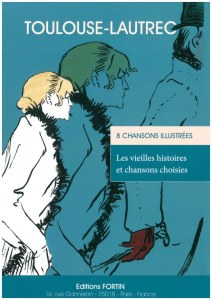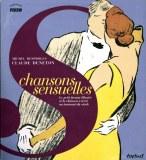Toulouse Lautrec 8 chansons illustrées : les vieilles histoires
EAN Code 8/13 or UPC code : 9 782910 6713
Everything has been said about the life of Toulouse-Lautrec, about his infirmity and his genius. Everything has been written and even filmed in the film studios of Saint-Maurice and Hollywood. It is therefore important here to mention his important role in the history of music publishing. In this field, his production represents almost a tenth of his lithographic work. Introduced to Ondet, by Ibels, he will realize for this publisher a great number of illustrations, from 1893 to 1900. Joubeit, Kouquet, Quinzard, La Sirène musicale, Bosc, Salabert, Paul Dupont and La Société musicale also published his lithographs.
Toulouse-Lautrec liked this activity and enjoyed having his relatives and friends appear on the covers of his small formats. Thus Désiré Dihau, a family relation, walks his jovial sixty on several scores including Pour toi. His sister, Marie, gave piano and singing lessons. In her youth she had a famous suitor: Edgar Degas. Thanks to her, Toulouse-Lautrec had been introduced to this master who had encouraged him and received him in his studio. He was both happy and proud. Désiré Dihau, bassoon at the Paris Opera, also composed melodies on poems by Jean Richepin, Hector Sombre or Jean Goudezki. These scores, of course, were always illustrated by the grateful painter. Other personalities appear in Toulouse-Lautrec's compositions: Misia the young wife of his friend Thadée Natanson, founder of La Revue Blanche. He was secretly in love with her: she was to be the cover of Sagesse. For Nuit Blanche, Rodolphe Salis, the owner of the Chat Noir, looking at the night, is taken as a model. He appears brown, while in reality, he is redheaded. The effect is due, no doubt, to the backlighting. More surprising is the layout - on stage, we should say - of Poor Stones. In front of the main character of the prostitute, we see the half-silhouette of a tall individual who seems to want to escape from the scene. This bourgeois who fears to be seen in such bad company, saves his anonymity thanks to the edge of the page! The customer who escapes is none other than Gabriel Tapié de Céleyran, cousin of the painter.
continuation see collection.......................................
The Small Formats
Simplified form of a score, the small format was by far the most widespread model. A sheet of ordinary paper, folded in two, provided the "work" with four good pages. The cover was usually decorated with an illustration related to the subject, more rarely with a logo. It could be printed in black, in color, sometimes in a single shade. The back page - or fourth page - was used for advertising purposes. The titles of the directory and the conditions of purchase were displayed. The thickness of the paper, the reduced dimensions and above all the folding, gave a certain hold to the document which could be used on improvised desks. On opening it, one could see its purpose: a monologue or a song, works for solo music being reserved for large formats. This design allowed the singer or musician to read the entire key to the score without having to turn a page. They were obtained almost everywhere: from booksellers, music dealers, resellers who stamped them, in galleries, those famous key passages of the capital. They were also sold in the street like newspapers, by groups of musicians, in markets, and by peddlers. The song merchant, holding his stall in one hand and brandishing a small format in the other, would call out to passers-by:
"Ask for the hit of the day!..."
The making
Invented in the 18th century by a German engraver, lithography made it possible to illustrate small formats quickly and cheaply. The first hundred proofs drawn by the artist and produced under his control constituted the first edition. They were printed on luxury papers: japon, chine and vellum. Intended for collectors, they were advertised on the scores. Each copy was signed by the artist's hand, in the margin and in pencil: blue for Ibels, red for Steinlen, graphite or orange monogram for Toulouse-Lautrec'.....suite voir recueil









